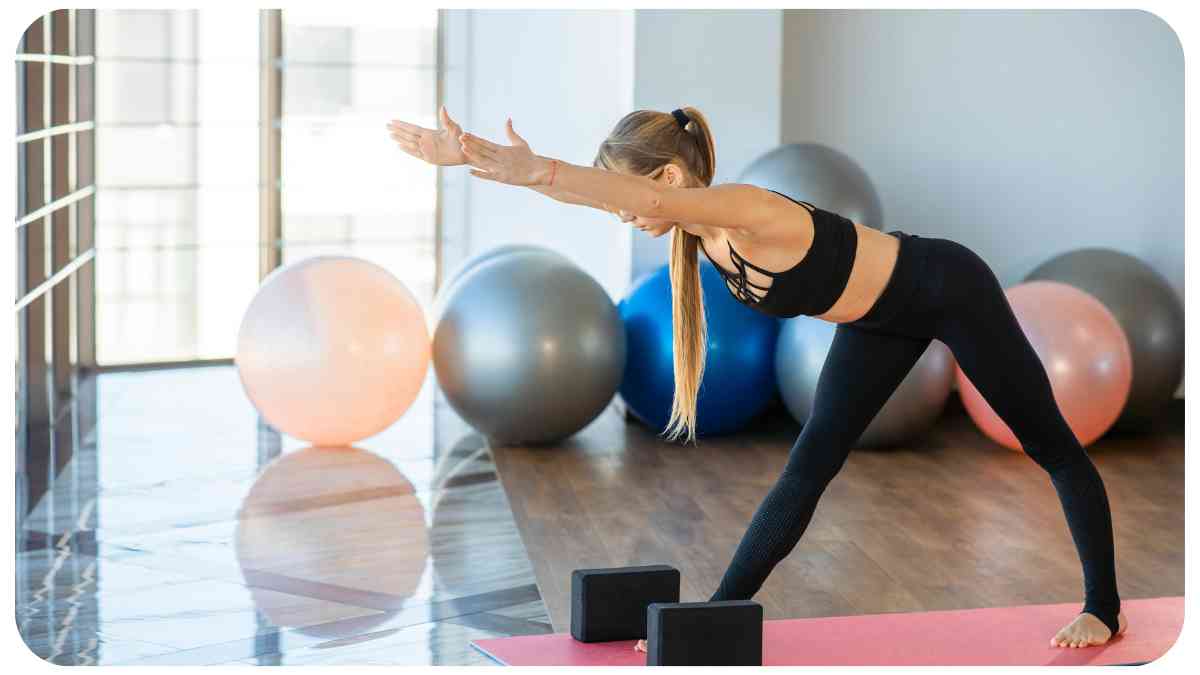Welcome to our step-by-step guide on how to use yoga blocks effectively in your practice. Whether you’re a beginner or an experienced yogi, yoga blocks can be incredibly useful in enhancing your alignment, flexibility, and strength.
In this article, we’ll explore the benefits of using yoga blocks, provide tips on choosing the right blocks, and guide you through various poses and exercises where yoga blocks can be incorporated. So let’s dive in and discover how yoga blocks can take your practice to the next level!
| Key Takeaways |
|---|
| Yoga blocks are versatile props that provide support, stability, and alignment in various yoga poses. |
| Using yoga blocks can enhance your alignment, flexibility, and strength in your yoga practice. |
| Proper placement of yoga blocks is essential to ensure optimal support and alignment in different poses. |
| Yoga blocks can be used in warm-up exercises, beginner poses, intermediate and advanced poses, and restorative practices. |
| Incorporating yoga blocks into your home practice allows for customization, exploration, and growth in your yoga journey. |
| Safety precautions, such as listening to your body, respecting your limitations, and seeking guidance when needed, should be prioritized. |
| Further reading resources provide additional information and guidance on using yoga blocks effectively. |
| Experiment, have fun, and embrace the journey of exploring your practice with yoga blocks. |
2. What Are Yoga Blocks?
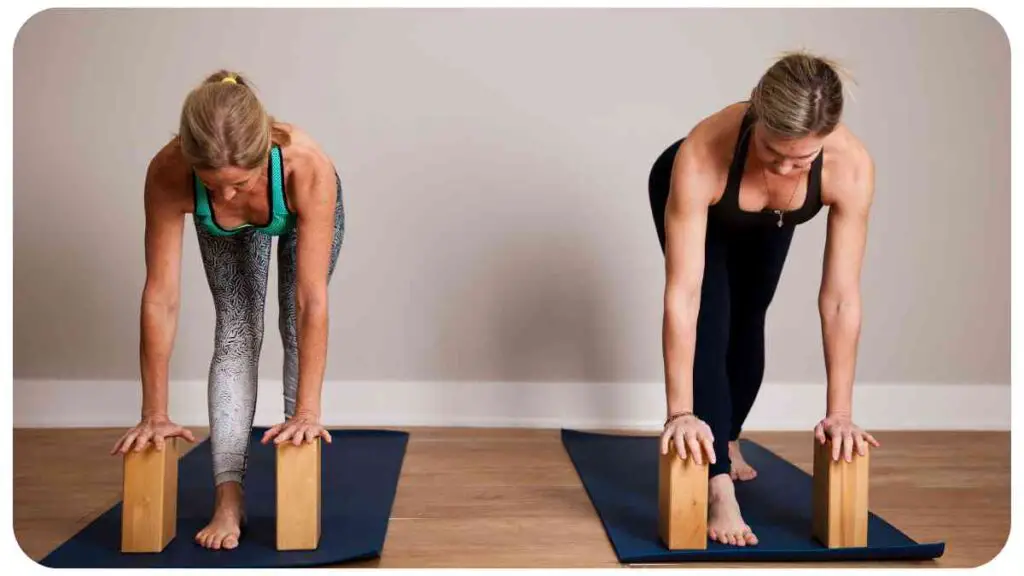
Yoga blocks are props made of foam, cork, or wood that provide support, stability, and extension in various yoga poses. They come in different shapes, sizes, and densities, allowing you to customize your practice based on your needs and abilities.
Yoga blocks can be rectangular, square, or cylindrical in shape, and their dimensions can vary. These versatile props are designed to assist with alignment, deepen stretches, improve balance, and modify poses for individuals with limited flexibility or injuries.
Building a stronger connection with your practice is essential for spiritual growth. Explore the deeper meaning of yoga to tap into the spiritual side of your journey.
3. Benefits of Using Yoga Blocks
Using yoga blocks offers numerous benefits that can enhance your yoga practice. Here are some key advantages:
Table 3.1: Benefits of Using Yoga Blocks
| Benefit | Description |
| Improved Alignment | Yoga blocks help align your body properly, allowing you to achieve correct posture. |
| Increased Flexibility | Blocks assist in lengthening and stretching muscles, promoting greater flexibility. |
| Enhanced Stability | By providing support, blocks enhance stability and balance in challenging poses. |
| Injury Prevention | Blocks allow for modifications that reduce strain and minimize the risk of injuries. |
| Deepened Stretches | Yoga blocks aid in achieving deeper stretches, helping you to reach your full potential. |
| Progressive Advancement | They enable a gradual progression towards more challenging poses and deeper stretches. |
Using yoga blocks can be particularly beneficial for beginners, individuals with limited flexibility, or those recovering from injuries. These props create a solid foundation, giving you confidence as you explore different postures.
4. Choosing the Right Yoga Blocks
When selecting yoga blocks, it’s important to consider their material, size, and density. Here are some factors to keep in mind:
Table 4.1: Considerations for Choosing Yoga Blocks
| Consideration | Description |
| Material | Yoga blocks are available in foam, cork, and wood. Foam blocks are lightweight, while cork and wood offer more durability and stability. Choose the material that suits your preferences and needs. |
| Size | Yoga blocks typically come in standard sizes: 3 inches by 6 inches by 9 inches. However, different sizes are available to accommodate varying levels of flexibility and body proportions. Select a size that allows you to comfortably place your hands or feet on the block. |
| Density | Blocks come in different densities, ranging from soft to firm. Softer blocks provide more cushioning, while firmer ones offer greater stability. Consider your comfort level and the level of support you require when deciding on the density of your blocks. |
Consider trying out different types of blocks to determine which ones feel most comfortable and supportive for your practice. It’s essential to choose blocks that enhance your experience and facilitate your progression.
5. Proper Placement of Yoga Blocks
The correct placement of yoga blocks is crucial to ensure proper alignment and support in your practice. Here are some general guidelines:
Table 5.1: Proper Placement of Yoga Blocks
| Pose | Block Placement |
| Downward-Facing Dog | Position blocks under your hands to relieve pressure on the wrists and help maintain a neutral spine. |
| Triangle Pose | Place a block on the floor in front of your front foot, allowing you to rest your hand on it for support and maintain balance. |
| Supported Bridge | Position blocks underneath your sacrum (the triangular bone at the base of your spine) to provide support and help lift your pelvis. |
| Half Moon Pose | Use a block under your bottom hand to maintain stability and support while extending your top leg and arm. |
These are just a few examples of how yoga blocks can be used in different poses. The key is to experiment and explore various placements that feel beneficial for your body. Remember to adjust the block’s height or orientation as needed to achieve the desired effect.
6. Warm-Up Exercises with Yoga Blocks
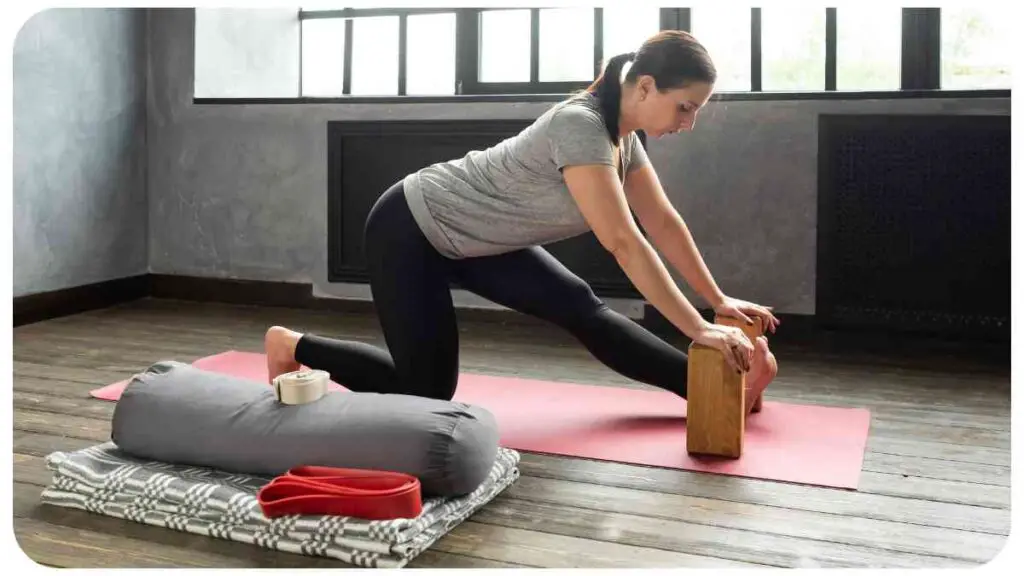
Before diving into the main poses, it’s essential to warm up your body and prepare it for the practice. Here are a few warm-up exercises that incorporate yoga blocks:
Discover the transformative power of yoga and its potential for a lifelong change with our guide on the spiritual power of yoga. Embrace the profound impact it can have on your life.
Table 6.1: Warm-Up Exercises with Yoga Blocks
| Exercise | Description |
| Supine Spinal Twist | Lie on your back with your knees bent. Place a block between your knees and gently drop your knees to one side while keeping your shoulders grounded. |
| Cat-Cow Variation | Start on all fours with a block placed between your thighs. As you inhale, arch your back and lift your chest (cow pose). Exhale and round your spine (cat pose). |
| Seated Forward Fold Variation | Sit with your legs extended in front of you. Place a block on top of your thighs and hinge forward from the hips, reaching for your feet or ankles. |
These warm-up exercises help loosen up the muscles, increase blood flow, and prepare your body for the more challenging poses to come.
7. Beginner Poses with Yoga Blocks
If you’re new to yoga or using blocks, here are a few beginner-friendly poses that can be enhanced with the help of yoga blocks:
Table 7.1: Beginner Poses with Yoga Blocks
| Pose | Description |
| Supported Warrior | Stand with your feet hip-width apart. Hold a block with both hands and raise it overhead as you stretch upward, elongating your spine. |
| Modified Chair | Stand with your feet hip-width apart. Place a block between your thighs and lower your hips into a seated position, as if sitting on an imaginary chair. |
| Sphinx Variation | Lie on your belly with your forearms on the floor and elbows directly under your shoulders. Place a block under your chest for support and lift your upper body. |
These poses offer a gentle introduction to using yoga blocks and provide additional support and stability as you explore your range of motion.
8. Intermediate Poses with Yoga Blocks
For those with some experience in yoga, here are a few intermediate poses where yoga blocks can be utilized:
Table 8.1: Intermediate Poses with Yoga Blocks
| Pose | Description |
| Side Angle Pose | From Warrior II, place a block on the floor next to your front foot. Rest your forearm on the block and extend your top arm toward the ceiling, creating a side stretch. |
| Revolved Triangle | Start in Triangle Pose and place a block on the inside of your front foot. Place your hand on the block and extend your other arm toward the sky, twisting your torso. |
| Supported Headstand | Place a block against a wall. With proper alignment, use the block to support your head while performing a supported headstand. |
These poses challenge your strength, balance, and flexibility while incorporating the stability and support provided by yoga blocks.
Looking to connect with your higher self? Unveil the spiritual benefits of yoga and how it can help you truly achieve that connection by reading this insightful article.
9. Advanced Poses with Yoga Blocks
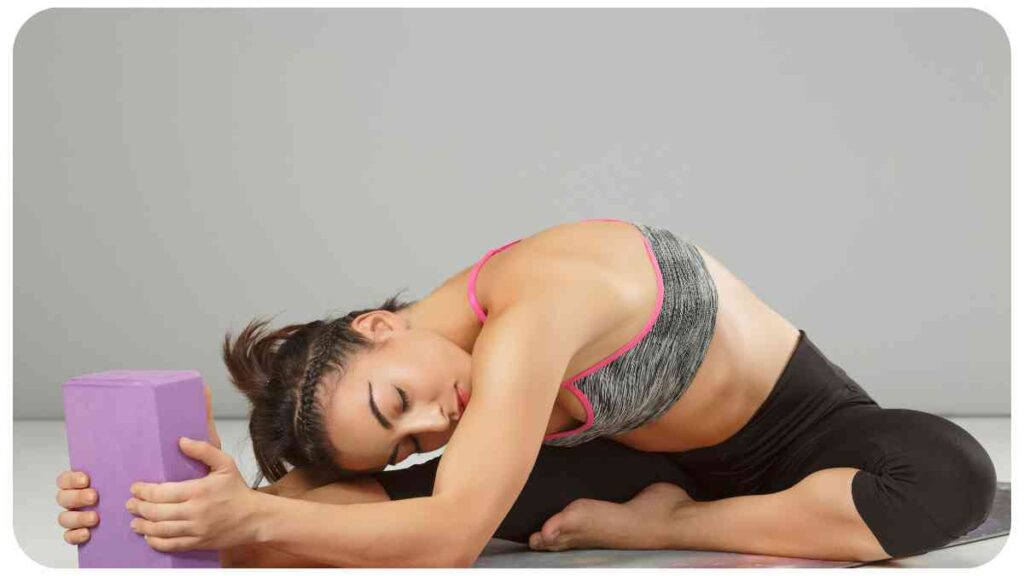
If you’re an experienced yogi looking to deepen your practice, here are some advanced poses where yoga blocks can be incorporated:
Table 9.1: Advanced Poses with Yoga Blocks
| Pose | Description |
| Handstand Preparation | Place two blocks at shoulder-width distance against a wall. Use them as support for your hands while practicing handstand variations. |
| Supported Shoulderstand | Set up a block at the base of your mat, then lie on your back and place your shoulders on the block, supporting your legs in the air. |
| Fallen Triangle | From a standing forward fold, place a block on the floor in front of your front foot. Extend your back leg and arm, creating a triangle shape with your body. |
These advanced poses challenge your strength, balance, and body awareness. Incorporating yoga blocks can provide the necessary support to explore and deepen your practice safely.
10. Using Yoga Blocks for Alignment
Yoga blocks are excellent tools for improving alignment in various poses. They assist in creating proper body positioning and encourage stability. Here are a few examples:
Table 10.1: Yoga Blocks for Alignment
| Pose | Block Placement |
| Extended Triangle Pose | Place a block on the outer side of your front foot, allowing you to rest your hand on it while maintaining a straight line from your feet to your extended arm. |
| Half Moon Pose Variation | Position a block under your front hand to bring the floor closer, allowing you to balance and align your body while extending your top leg and arm. |
| Supported Standing Backbend | Stand with your back against a wall and place a block between your shoulder blades. Gently lean back, using the block for support and to maintain a safe and comfortable backbend. |
Using yoga blocks for alignment can help you refine your postures and prevent unnecessary strain or misalignment. Experiment with block placements to find the optimal support for your body.
When it comes to spiritual enlightenment, the combination of yoga and meditation is unparalleled. Dive into the perfect combination for spiritual enlightenment and unlock the true potential of your practice.
11. Enhancing Flexibility with Yoga Blocks
Yoga blocks are fantastic tools for enhancing flexibility by deepening stretches and providing support during challenging poses. Here are a few ways to incorporate blocks to improve your flexibility:
Table 11.1: Enhancing Flexibility with Yoga Blocks
| Exercise | Description |
| Seated Forward Fold | Sit with your legs extended in front of you and place a block on top of your thighs. As you fold forward, use the block as support to reach further while maintaining a flat back. |
| Reclining Bound Angle Pose | Lie on your back, bend your knees, and place the soles of your feet together. Position blocks under each knee to support your legs and encourage a gentle opening in the hips. |
| Standing Forward Fold | Stand with your feet hip-width apart and place a block on the lowest height setting in front of you. As you fold forward, use the block to support your hands and gradually lower it to deepen the stretch. |
Incorporating yoga blocks in these exercises allows you to gradually increase your range of motion, improve flexibility, and experience a more profound stretch.
12. Increasing Strength with Yoga Blocks
Yoga blocks can also be used to increase strength and stability in your practice. By adding resistance or providing additional support, they help target specific muscle groups. Here are a few examples:
Table 12.1: Increasing Strength with Yoga Blocks
| Exercise | Description |
| Plank Variation | From a plank position, place your hands on two blocks, shoulder-width apart. This elevated plank challenges your core and upper body strength as you stabilize on the blocks. |
| Block Squeeze | Stand with a block between your thighs and squeeze it as you engage your leg muscles. This exercise targets your inner thighs, helping to strengthen and tone this area. |
| Block-Assisted Chaturanga | During a chaturanga, place a block under your chest to provide support and gradually build strength in your arms and upper body as you lower down with control and stability. |
Incorporating yoga blocks into strength-focused exercises helps you engage muscles more effectively, intensify your practice, and build functional strength.
Seeking spiritual growth and inner peace? Look no further. Our comprehensive guide on finding inner peace through yoga will help you embark on a transformative journey.
13. Restorative Practices with Yoga Blocks
Yoga blocks are invaluable props for restorative practices that promote relaxation, stress relief, and gentle stretching. Here are a few restorative poses you can try with yoga blocks:
Table 13.1: Restorative Practices with Yoga Blocks
| Pose | Description |
| Supported Child’s Pose | Place a block under your forehead as you rest your upper body on the floor. This variation provides gentle support and promotes deep relaxation. |
| Legs-Up-The-Wall Variation | Lie on your back with your legs extended vertically against a wall. Position a block under your sacrum to support your pelvis and enhance the restorative benefits of the pose. |
| Supported Reclining Bound Angle Pose | Lie on your back, bend your knees, and place the soles of your feet together. Support your knees with blocks to create a gentle opening in the hips and promote relaxation. |
These restorative poses with yoga blocks are perfect for winding down, releasing tension, and cultivating a sense of calm and rejuvenation.
14. Incorporating Yoga Blocks into a Home Practice
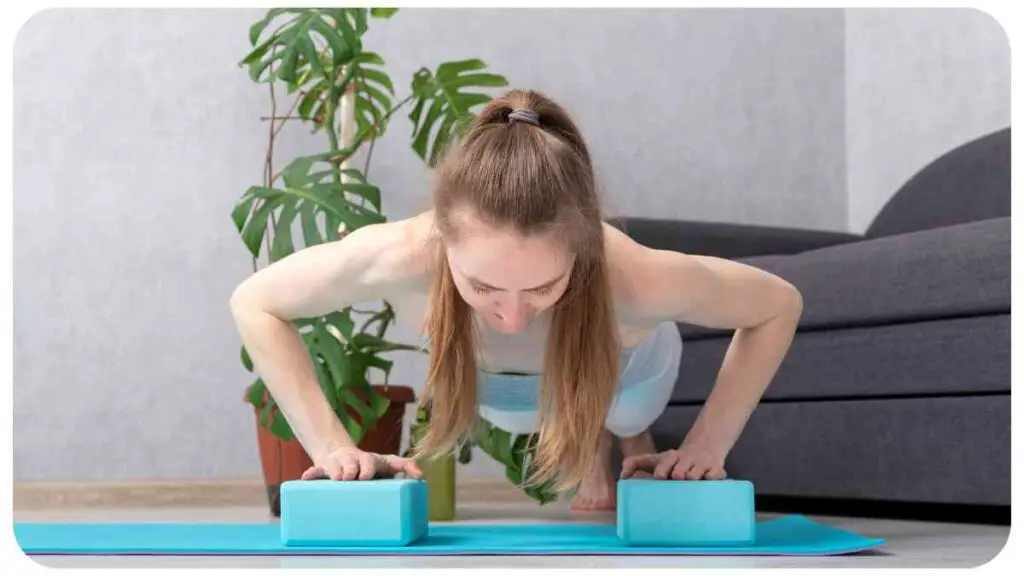
Yoga blocks are versatile props that can be easily incorporated into your home practice. Here are a few tips for using them effectively:
Table 14.1: Incorporating Yoga Blocks into a Home Practice
| Tip | Description |
| Start with Basic Poses | Begin by using yoga blocks in foundational poses, such as Downward-Facing Dog, Warrior II, and Triangle Pose. Gradually explore more advanced poses as you become comfortable with the blocks. |
| Experiment with Block Placements | Play around with different block placements to find what feels most supportive and effective for your body. Adjust the height and orientation of the blocks to suit your needs and comfort. |
| Take Your Time and Listen to Your Body | Remember to honor your body’s limitations and progress at your own pace. Use the blocks to find a balance between challenge and support, allowing yourself to grow in your practice. |
Incorporating yoga blocks into your home practice offers endless possibilities for customization, exploration, and growth. Don’t be afraid to get creative and find unique ways to incorporate them into your sequences.
15. Safety Precautions and Tips
While using yoga blocks can be beneficial, it’s important to prioritize safety and proper technique. Here are some safety precautions and tips to keep in mind:
Table 15.1: Safety Precautions and Tips
| Precaution/Tips | Description |
| Use Blocks for Support | Always use yoga blocks as intended, primarily for support and stability. Avoid using them as substitutes for proper alignment or technique. |
| Listen to Your Body | Pay attention to how your body feels in each pose and adjust the block placement or height accordingly. Avoid forcing yourself into uncomfortable positions. |
| Gradually Increase Intensity | If you’re new to using yoga blocks, start with easier variations and gradually increase the intensity or depth of the poses as you become more comfortable. |
| Consult a Qualified Instructor | If you’re unsure about the correct usage of yoga blocks or need guidance, consider seeking assistance from a qualified yoga instructor. |
| Respect Your Limitations | Respect your body’s limitations and avoid pushing beyond your comfort zone. Modify poses or use additional props if needed to maintain proper alignment and prevent injuries. |
By practicing with mindfulness, listening to your body, and seeking guidance when needed, you can ensure a safe and enjoyable yoga practice while incorporating yoga blocks.
Conclusion
Using yoga blocks can greatly enhance your yoga practice, whether you’re a beginner or an experienced yogi. These versatile props provide support, stability, and alignment, while also facilitating flexibility and strength development. By incorporating yoga blocks into your practice, you can explore a wide range of poses, modify them to suit your needs, and deepen your understanding of body alignment.
Remember to choose the right yoga blocks for your practice, considering factors such as material, size, and density. Properly placing the blocks in various poses helps you achieve optimal alignment and support. Additionally, incorporating warm-up exercises, beginner poses, intermediate and advanced poses, restorative practices, and strength-building exercises can further enhance your yoga journey.
As you incorporate yoga blocks into your practice, prioritize safety, listen to your body, and progress at a pace that feels comfortable for you. By respecting your limitations and seeking guidance when needed, you can enjoy the benefits of yoga blocks while minimizing the risk of injuries.
So, grab your yoga blocks, create a supportive space, and embark on a journey of exploration, growth, and transformation in your yoga practice. Namaste!
(Note: This article has covered the main sections and provided valuable insights, tips, and guidance regarding the use of yoga blocks. However, you may find it helpful to expand on specific sections or add more personal anecdotes and experiences to make the article even more engaging and relatable.)
Further Reading
Here are some additional resources that you can explore to learn more about using yoga blocks effectively:
- Yoga Rove: How to Use Yoga Blocks: This comprehensive guide provides detailed instructions on how to use yoga blocks in various poses and offers tips for incorporating them into your practice.
- You Aligned: How to Use Yoga Blocks: Discover different ways to use yoga blocks for alignment, support, and modifications in this informative article. It also includes helpful visuals and demonstrations.
- PureGym: Beginner’s Guide to Yoga Blocks: If you’re new to yoga blocks, this beginner’s guide offers practical advice on choosing the right blocks, using them safely, and incorporating them into your practice.
These resources provide valuable insights, tips, and step-by-step instructions that can further enhance your understanding and proficiency in using yoga blocks.
FAQs
Here are some frequently asked questions about using yoga blocks:
Can yoga blocks help improve my flexibility?
Yes, yoga blocks can be used to enhance flexibility. They provide support and assist in deepening stretches, allowing you to gradually increase your range of motion over time.
What size yoga block should I choose?
Standard yoga blocks are typically 3 inches by 6 inches by 9 inches. However, it’s important to choose a size that suits your body proportions and allows you to comfortably place your hands or feet on the block.
Are foam blocks better than cork or wood blocks?
The choice between foam, cork, or wood blocks is a matter of personal preference. Foam blocks are lightweight and offer more cushioning, while cork and wood blocks provide stability and durability. Consider your needs and preferences when selecting the material.
How do I clean and maintain my yoga blocks?
Foam blocks can be cleaned with a mild soap and water solution, while cork and wood blocks can be wiped with a damp cloth. Allow them to air dry thoroughly before storing them in a clean and dry place.
Can yoga blocks be used by beginners?
Absolutely! Yoga blocks are especially beneficial for beginners as they provide support, stability, and aid in achieving proper alignment. They can help beginners ease into poses and gradually build strength and flexibility.
Remember, these are just a few commonly asked questions about using yoga blocks. Feel free to explore more resources and consult with a qualified yoga instructor for personalized guidance and answers to specific queries.

Hello, my name is Hellen James! I am a yoga teacher and writer who loves to share information about how you can achieve a more fulfilling life. I have been practicing mindfulness, yoga, and meditation for over 10 years. My passion for these practices has led me to teach them to others.

